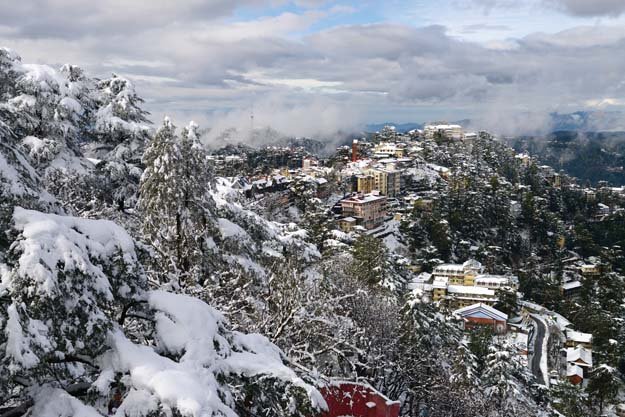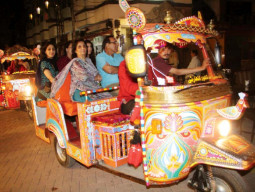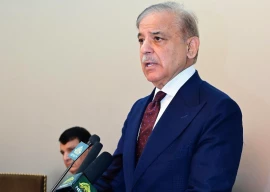

A view of Christ Church and library from Mall Road. PHOTOS : VASIQ EQBAL
Suddenly, someone in the van broke the deep silence. “Would we be lucky enough to see snowfall in Shimla?” asked an inquisitive voice. A few wishful whispers echoed in uncertainty. A few moments later, visibility dropped and, as if on cue, snowflakes began to trickle down our windscreen, welcoming us to Shimla.
The next day, I was woken up by a fellow traveller just after dawn. The sun hadn’t completely emerged from behind the mountains, but the light at the horizon was enough for me to soak in the beauty of Shimla. Last night’s snowfall had draped everything in white. Deserted but dazzling, the view was breathtaking.
Shimla has a lot of history attached to it. From 1864 till Partition, the famous Indian hill station was declared the summer capital of British India. Etymology reveals that it was named after Hindu goddess Shyamala Devi, an incarnation of goddess Kali. The city is also the birthplace of former governor of Punjab Salmaan Taseer, television actor Rahat Kazmi, economist Shahid Javed Burki, Bollywood actor Anupam Kher and former English cricket captain Robin Jackman. Military dictator Ziaul Haq and former Afghan president Hamid Karzai even received their early education from Shimla.

The monkey who plundered our pastries. PHOTOS : VASIQ EQBAL
After breakfast, we all went out to explore the city. Our first destination was perhaps the most unlikely place for a tourist: a police station. Due to strained relations between both governments, laws for Pakistani citizens are different from the rest. Pakistani tourists are required to report at police stations in every city they visit in India. Thankfully, the exercise was over within 15 minutes.
By now, Mall Road was teeming with people. The road begins from the place of a tall statue of Mahatma Gandhi and one of Indira Gandhi to the right. The famous Christ Church, library and administrative offices also straddle the road. Passing through it, the tantalising aroma of fresh coffee wafting through the air lured us to the establishment in question. A group member and I bought two cups of coffee and black forest pastries and were enjoying our snack on a nearby bench when we were suddenly attacked. Our attacker was not from the Border Security Police, Indian police or the bhai log of Bollywood, but from the animal kingdom — a monstrous monkey. It sneaked up from behind, pinched one of the remaining pastries and gobbled it instantly. The violation led us to abandon the bench and move on to see what else Shimla had to offer.
The platitudes of tourist brochures describing the scenic beauty of Shimla are not entirely misleading. It is definitely a place worth visiting. A ban imposed on all vehicles on Mall Road by British colonial rulers is still in place today. Despite the large number of visitors, the administration is trying hard to preserve the environment. Smoking in public is punishable with a fine of Rs500, while a penalty of Rs300 is slapped for spitting chewing gum on the streets. Wherever we shopped, paper bags were used. In grocery stores, people bought along their own cloth bags. Plastic pollution was almost non-existent, making one realise the need for a similar practice in Murree.

Dark clouds hover above Shimla after the snowfall. PHOTOS : VASIQ EQBAL
Shimla is built on top of seven hills — Prospect Hill, Summer Hill, Observatory Hill, Inveram Hill, Bantony Hill, Jakhoo Hill and Elysium Hill. Jakhoo is the tallest of the seven, at a height of 2,455 metres above sea level. There is a temple on this hill, which was erected even before the British declared Shimla the summer capital. The red temple of god Hanuman is 108 metres tall, visible from almost every corner of the town. To reach the temple, one has to endure a steep climb of 2.5 kilometres.
The railway track of Shimla is also a Unesco world heritage site. The track snakes through more than a hundred manmade tunnels and the journey is famous for its splendid views. There is a famous tale about the Borog tunnel, the longest one. The engineer who made it could not align the two ends and was symbolically fined one rupee. He, however, could not live with the disgrace and committed suicide inside the tunnel. Later, another engineer had to complete it.
After a tiring hike around town, I bought a Himachal cap as a souvenir and returned to the hotel. From the roof, I was able to capture a shot of the spectacular sunset. It certainly won’t be easy to forget this beauty that lies just beyond the border.
Vasiq Iqbal is a Lahore-based photojournalist and travel writer.
He tweets @ vasiq_eqbal.
Published in The Express Tribune, Sunday Magazine, June 14th, 2015.
































1714024018-0/ModiLara-(1)1714024018-0-270x192.webp)









COMMENTS (6)
Comments are moderated and generally will be posted if they are on-topic and not abusive.
For more information, please see our Comments FAQ